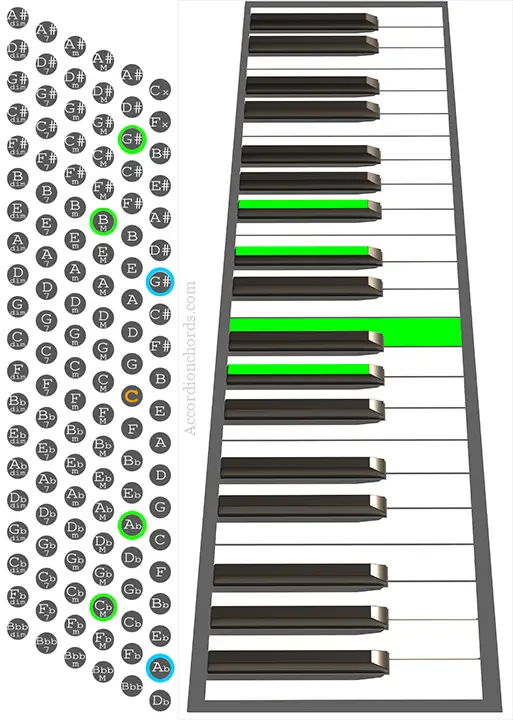AKA: Abm7, Abmin7, Ab minor 7th, Ab minor seventh
Abm7 Chord on Piano Accordion

Minor 7th Chords
Minor 7th chords can be created by starting with a minor triad (a chord consisting of a root note, minor third, and perfect fifth) and adding the minor 7th note to the chord. They are built taking a root note, a minor 3rd, a perfect 5th, and a minor 7th. Alternatively, you can build a minor chord by creating a minor 3rd and then adding a major 3rd and a minor 3rd interval.
As an example, if you take the root, minor 3rd, perfect 5th, and minor 7th degrees of the C major scale (C, Eb, G, Bb), you will have a C minor 7th chord (Cm7), where the intervals between the notes are a minor 3rd (C-Eb), a major 3rd (Eb-G), and a minor 3rd (G-Bb).
Equivalent chord:
The first inversion of a min7th chord is equivalent to a 6th chord. The minor third of the min7th chord is the root of the 6th chord.
In this case:
I° inversion of A♭m7 (A♭, B, E♭, G♭) = B6 (B, D#, F#, G#)
(Please note that chord inversions do not work on the Stradella bass system like they do on other instruments or on the accordion keyboard itself. So although these equivalent chords have the exact same notes, they are not interchangeable and should not be intended as inversions of the same chord, at least for what concerns the left hand.)
Minor 7th Chords on Accordion
On the accordion you can play minor 7th chords by combining a root note and the Major chord built on the minor 3rd interval.
For example, in the key of C the minor 3rd is Eb and combining a C with an Eb Major (Eb, G, B) you get a Cm7 (C, Eb, G, B).
The Stradella layout of the accordion allows you to play minor 7th chords in two ways: you can choose to play the root note on the roots or on the counter bass column. It’s important to practice playing the chord in both positions, as the counter bass can sometimes be distant from the chords that are usually played around a particular key.

Notes:
A♭, C♭, E♭, G♭
(A♭, B, E♭, G♭)
Intervals:
R, m3°, 5°, m7°
Left hand:
A♭ + C♭M (G# + BM)
Fingering:
2 + 4 or 4 + 2